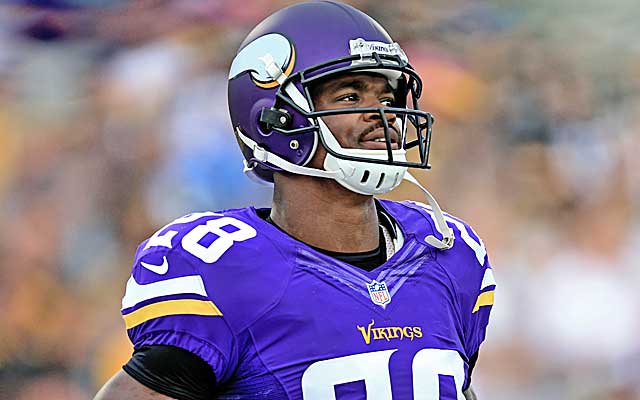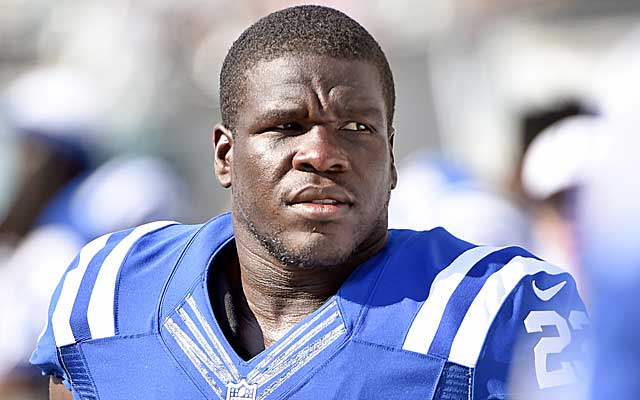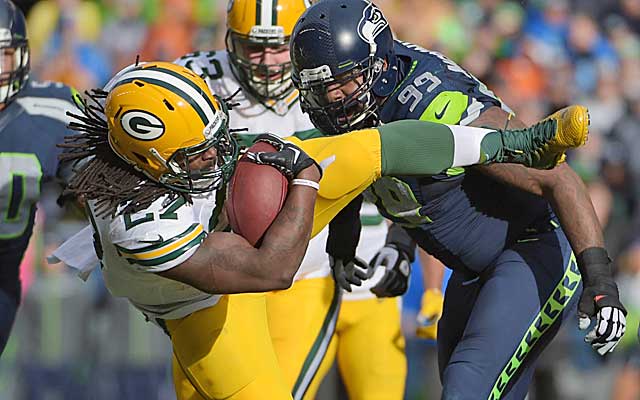Minnesota Vikings running back Adrian Peterson, perhaps the last in a dying breed of runners who stay with one team with a chance to perform at a high level past the age of 30, prefers that his son plays quarterback. Not a runner, but a thrower.
Indianapolis Colts running back Frank Gore, another 30-plus runner with a lot of bumps and bruises on his body from a career of brutish runs, wants his son to play cornerback.
And the running back position isn't dying?
"My son is going to play quarterback," Peterson jokingly said earlier this summer during a break in camp. "No, really, he can play whatever position he wants, but I will push him to play quarterback or some other position. We do a lot with our bodies. I've had seven surgeries. On the outside looking at kids, it's smart to say you want to be back there like Peyton Manning where guys don't hit you like they hit us."

Us is the running backs, perhaps the most-persecuted position players in the league, the glamour boys of the 1960s and 1970s, and even the 1980s, who are now considered appendages to the offense, rather than the focal point.
No more lead roles anymore. It's mostly supporting actor nominations.
When I told Gore what Peterson said about his son playing quarterback, Gore's face widened with a smile.
"I agree," Gore said. "I want my son to play corner. You can play a long time and not take a lot of hits. At running back, you get hit every play, with the ball, without the ball. This is a tough job."
The NFL has evolved into a wide-open, chuck-it-around league. It's the result of the rules changes over the last two decades, as well as the wising up of some old-school coaches who finally realized throwing to score and running to win is the formula most likely to success.
In the process, the quarterback position, which has always been loaded with glamour boys, has grown even more in stature. The NFL has always been a quarterback league, but once upon a time it was a running back league, too.
They were side by side, with books written about both, magazine covers dedicated to the star runners and passers and first-round picks. Big contracts went to both positions.
Now it's the quarterbacks getting the mega-deals, going in the first round of the draft, while the runners hope they can make it to a second contract, healthy enough to do so, hoping a younger, healthier back, with less wear on the tread, doesn't take your job.
In 2013 and 2014, we didn't see a running back taken in the first round of the NFL Draft. When it didn't happen in 2013, it broke a 49-year streak. Two runners did go in the first round this year -- Todd Gurley and Melvin Gordon -- but don't get any ideas that the backs are on their way back to prominence again.
That's your daddy's football.
The last running back to go first overall in the draft was in 1995 -- 20 years ago. It used to be commonplace. Players like Earl Campbell, Billy Sims and George Rogers went first in the late 1970s and early 1980s. Rogers was picked ahead of Lawrence Taylor, who went on to be a Hall of Fame linebacker.
Think about that for a second: A running back ahead of an elite edge rusher. Never happens now.
"The game has changed, so the value of the backs has changed," Arizona Cardinals coach Bruce Arians said. "We used to run the ball, and you needed a good, lead back. So they went early in the draft. Now you can find them in the later rounds and they're just as good as the first-round guys. So why waste the pick?"
The Seattle Seahawks won a Super Bowl two years ago with Marshawn Lynch leading the ground game, but the reality is they won it with a defense that was top-ranked in the league with Lynch and Russell Wilson hitting big plays to complement it. Without that defense, Lynch isn't carrying that team.
"Go back 15-20 years and you won't find a back who carried a team to a Super Bowl," Arians said. "It's quarterbacks."
There was more money being given to veteran backs this spring in new deals, which spurred some talk that the backs were back. It bucked recent trends, so it's worth noting. The Eagles paid Cowboys running back DeMarco Murray, who led the league in rushing, a big deal to switch teams. The Eagles had previously traded LeSean McCoy to the Bills, who then gave him a new deal. Peterson also got a new deal to give him some guarantees. Gore signed as a free agent with the Colts.
"I think it is coming back," Gore said. "Look at some of the deals out there. Guys got paid."
Even so, most teams are usually afraid to pay second deals to running backs. It usually doesn't work out. The wear-and-tear on a runner's body can be brutal. Four years of collisions that sometimes have the force of two cars colliding tend to wear a player down -- no matter how tough and how bruising a back he can be.

Green Bay's Eddie Lacy is one of the more powerful backs in the league. But he says the days after a game aren't fun.
"On Monday and Tuesday, it's tough," he said. "You feel it. Once you get going later in the week, you're ready to play again. Then it starts all over again."
That wears down a player. Each carry is like chipping away at the career. That's why runners who turn 30 are often looked at as old men, broken-down shells of themselves.
Peterson and Gore are trying to buck the trend, with Gore turning 32 last March. There have been 26 seasons where a back 30 or older has rushed for 1,000 yards since 1990. Of those 26, only 11 averaged 4.5 yards per carry or more.
"For me, 30 is the new 21," Peterson said. "I want to change people's minds when they talk about 30. So many people get caught up in a back's age and how they hit the down slope at 30. Guys end up believing it. But the mind is a powerful thing. You can accomplish anything if you set your mind to it. I have that mindset where 30 is just a number. If you keep your body in shape, have the right mindset, then you can do some amazing things. I've seen it."
Peterson then brings up Bruce Lee. Yes, the martial arts star.
"Look at Bruce Lee," Peterson said. "He weighed 145 to 150 pounds and he was powerful, so strong, so explosive. You see 43-year-old guys run 4.3s because of mindset. You have to program your mind: I can. I can. I can."
With the way things are going, kids aren't going to want to play running back anymore. For decades, they fought to be the runner on the Pop Warner team. Glamour came with it. It was simple: Pitch them the ball, and off they ran.
Now kids play receiver, corner and quarterback. They can flash those skills in those seven-on-seven camps, where backs have to wait to show their toughness and ability to run with the football until the pads go on, and the shots start to come. Sure, they can catch passes at those camps, but it's not the same evaluation as it might be for the receivers and corners. You can't really tell if a runner is any good until he runs between the tackles.
"We all wanted to be backs," Lacy said. "I see how that's changing now." One has to wonder if the backs will ever come back in vogue in the NFL. Vikings coach Mike Zimmer thinks they will. He said the way teams are playing now, with so many speed players on defense, rather than bulk, that it will transition back.
"I think it will turn around," Zimmer said "The league has become such a passing league now. I used to listen to guys like (Joe) Paterno and (Bill) Parcells and they always said when the league becomes a passing league, they would get big, physical guys and maul those smaller defenders and run all over them. Football is cyclical. I do think the running back will come back."
One flaw in the plan, Zimmer said, is how high schools and colleges are now putting their best athletes outside at receiver and at other spots. Zimmer also thinks the retirement of veteran passers like Peyton Manning, Tom Brady and Drew Brees will force the tide to shift to the backs. Peterson and Lacy naturally agreed.
"I think in a couple of years when the Peyton Mannings and Tom Bradys start to retire, and the next batch of quarterbacks that come through for the next 10-15 years, and you don't get many of the Andrew Luck kind of guys, you will definitely see more of a move to the running game," Peterson said. "It's coming."
"Everything is a cycle," Lacy said. "It has to come back at some point. The quarterbacks that are super, super good only come around so often. The backs will come back."
Arians doesn't buy it.

"They'll just find more quarterbacks," he said. "[Running backs] will always be around. And as far as drafting them high, you can find them in the third fourth- or fifth-round and you run a bunch of them if you can. That's why teams wait. I don't see it coming back as the glamour spot."
That doesn't mean guys like Peterson, Lacy and Gore won't do their best to try and bring it back -- even with two of them at advance running back age.
"We're keeping hope alive," Peterson said. "Even if they are trying to de-value our position."
Not trying. Sorry to say, it's done.
















